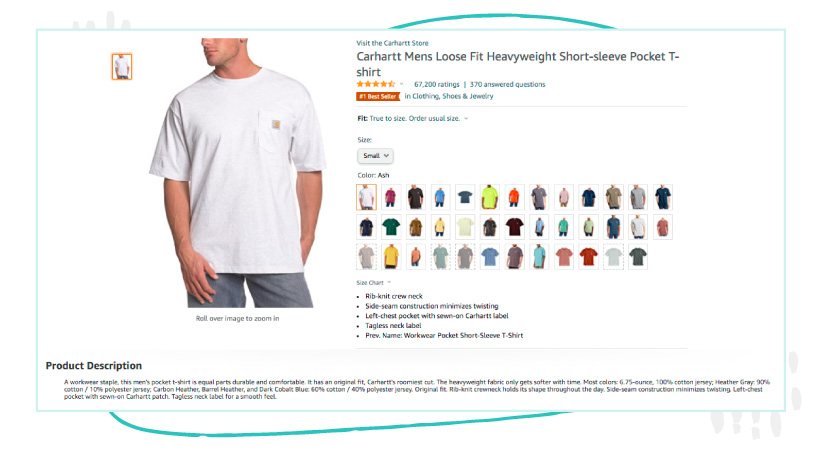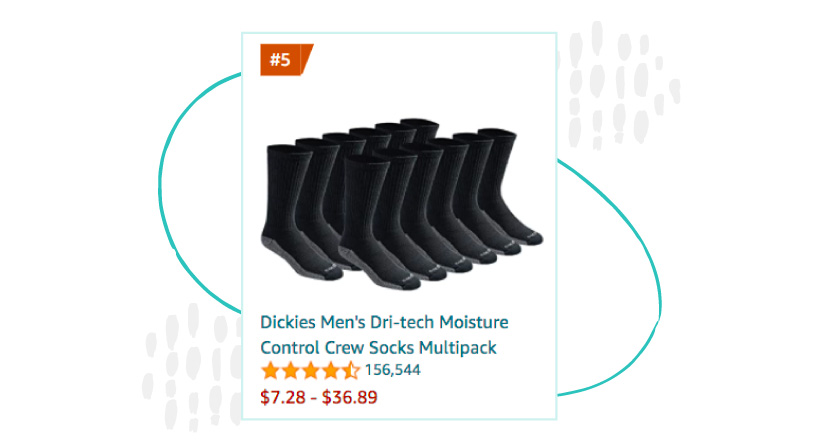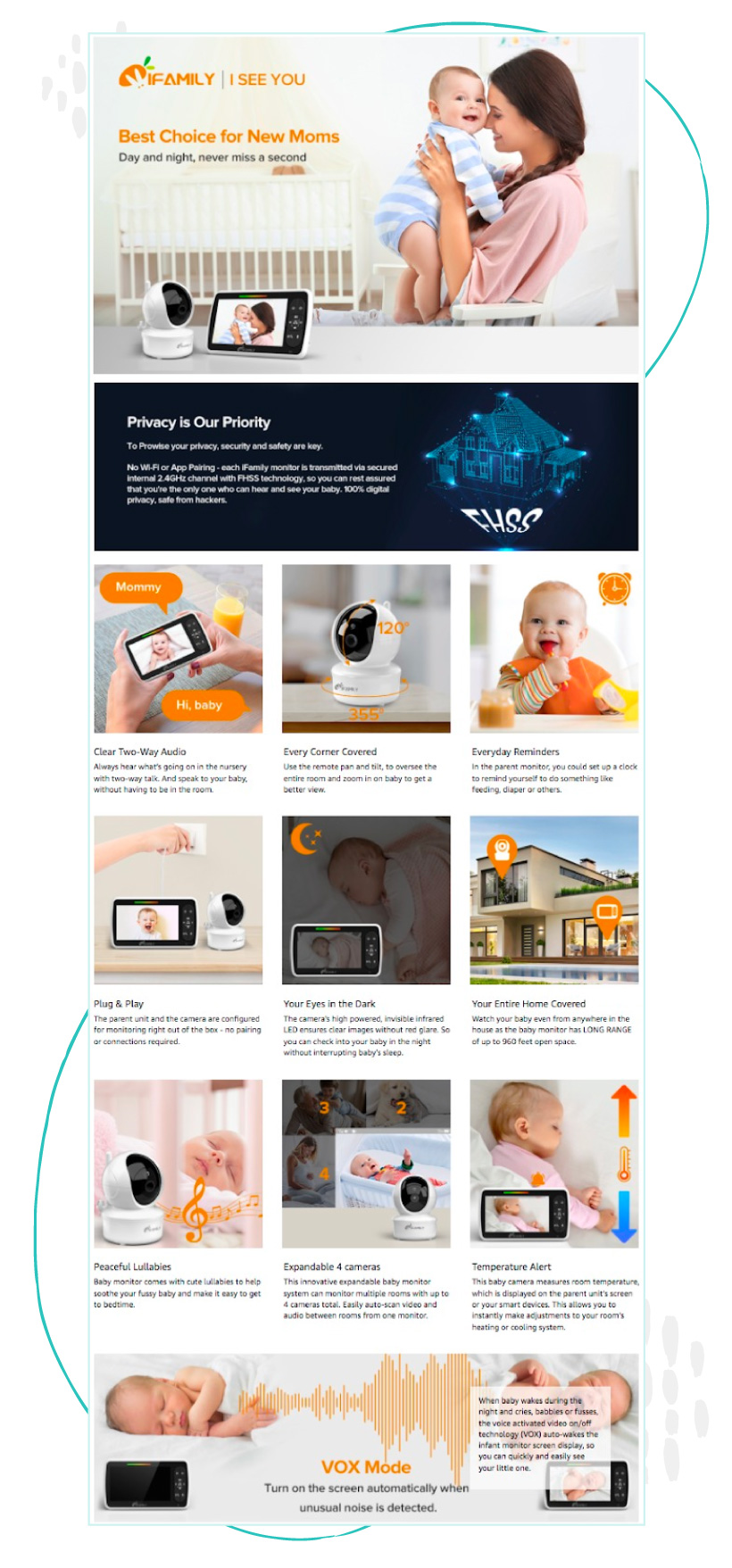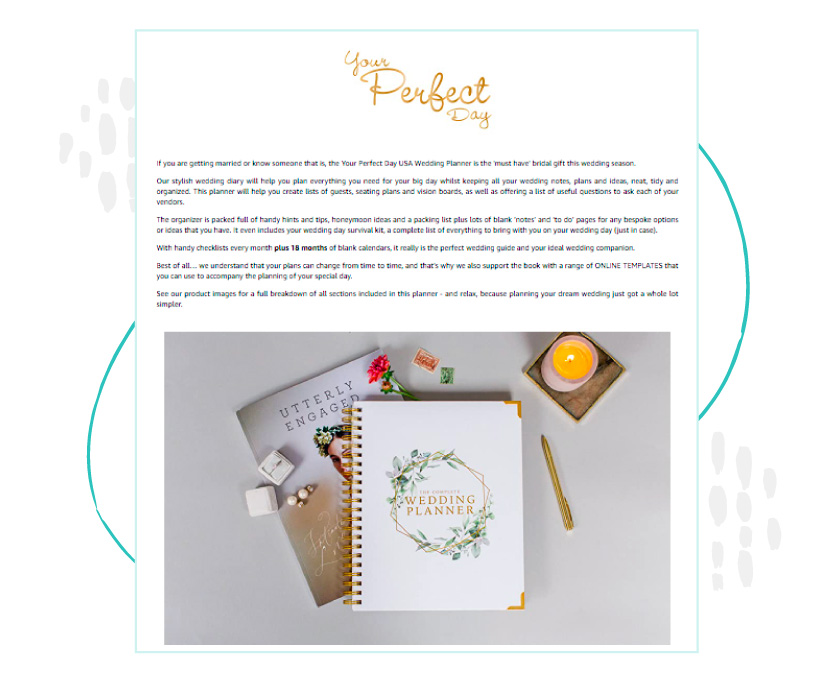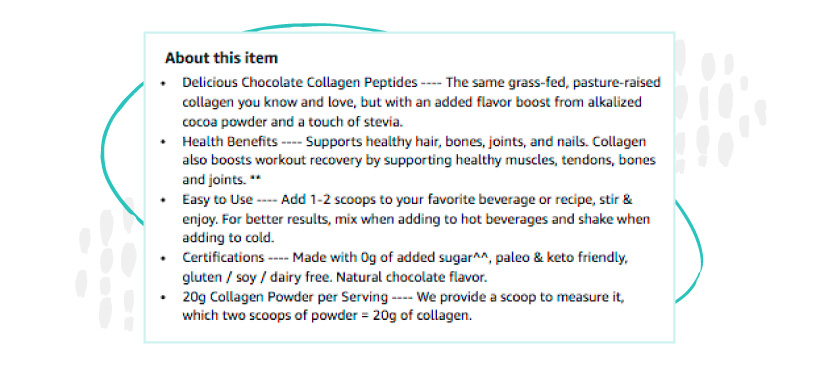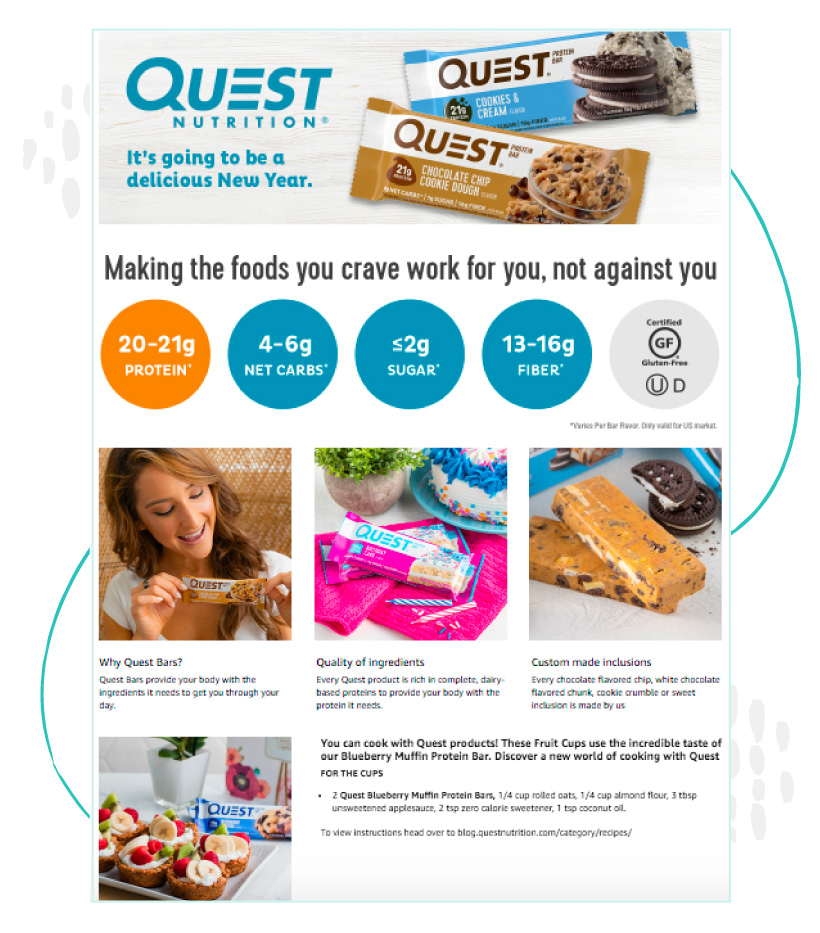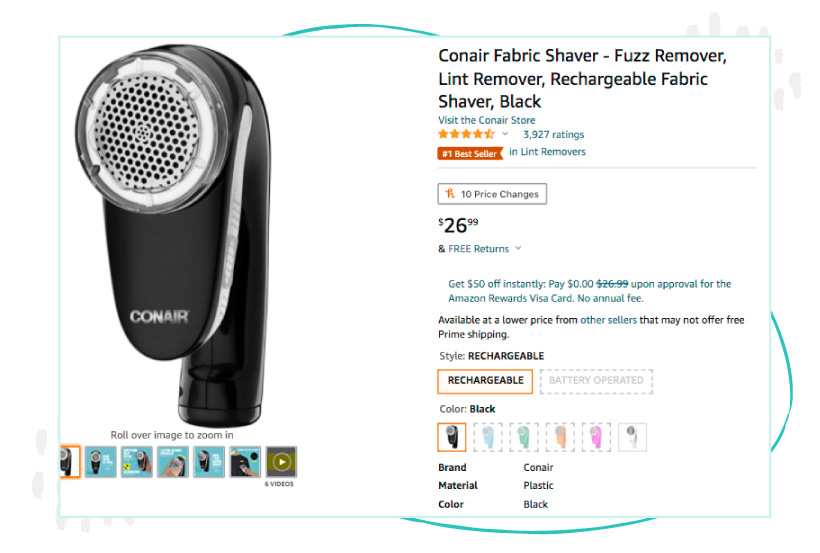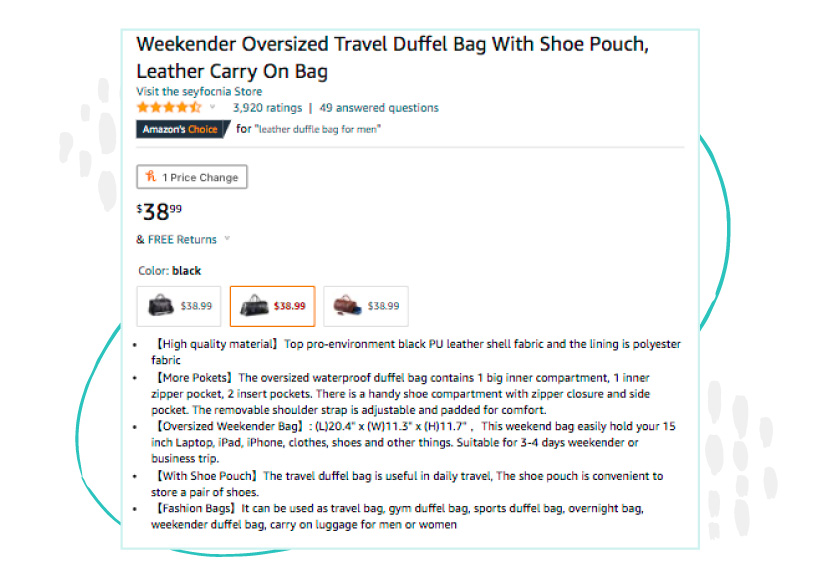If your product is directly competing with a product listed on Amazon — and that’s most products today — it’s time to create your product listing in Seller Central.
Amazon’s platform removes the pain points of customer acquisition. Your brand becomes a part of a buyer’s journey from the beginning with Amazon’s vast and loyal customer base. According to research by JPMorgan, Amazon is on track to be the largest U.S. retailer in 2022 and will overtake Walmart. Your brand’s success on Amazon, however, relies on your understanding and ability to write Amazon product descriptions that do three things: catch buyers’ attention, convince them that your product is the best choice, and convert them into customers through purchases and subscriptions.
9 tips for creating irresistible Amazon product descriptions
You will also need to know and abide by Amazon’s product description guidelines. Getting all of these things right isn’t as easy as it may appear. That’s why we’ve created this guide on nine of the most important copywriting tips to ensure your Amazon product descriptions are winning over customers (and Amazon) and driving sales growth.
1. Know what an Amazon product description is and is not
Amazon’s Seller Central offers a wealth of knowledge to set sellers up for success. Maybe even more importantly, it shares exactly what Amazon wants and requires for product descriptions and listings. Your product description should assist the customer in understanding your product, and more importantly, its unique features and benefits.
Here are some key points Amazon highlights that a product description should be:
- A concise, honest, and friendly overview of your product’s uses and where it fits in its category.
- Features and benefits of the product and a focus on its unique properties.
- Written clearly and concisely to help customers understand the product.
- Reviews the best applications for the product.
- Grammatically sound before submission.
- Competitors should not be mentioned or included.
- Text only with a limited number of characters.
- Follow all of Amazon’s standards.
An Amazon product description is not a place to:
- Untactfully stuff keywords.
- Compare your product to competitors or plagiarize their listings.
- Promote your external website.
- Write long descriptions of the details of your product.
- Include details about your company or other products you sell.
Amazon is also very clear about how they want their sellers to format their product descriptions.
Amazon’s product description template includes three sections:
- A product title: This should be kept to 200 characters (preferably less).
- A bulleted key product features section: This allows for concise bullets up to 500 characters.
- The main product description section: This section allows up to 2,000 characters that follow the above guidelines.
Amazon product description example
We’ll cover more about these sections below. Here’s a great example of a concise, yet highly effective, product description from an Amazon Best Seller.
2. Your e-commerce copywriting should focus on the product benefits
When it comes to selling your products on Amazon, it’s all about your product’s benefits, and not so much your product details. Let’s revisit Amazon’s three-section template above in more detail to see how to apply this to your Amazon product description copywriting.
Have your Amazon product title highlight one main benefit.
While Amazon allows a 200-character limit for product titles, you want to aim closer to 80 characters and do more with less. You’ll learn a little further down in this article about the importance of keywords within your title. Let’s take a look at an example of a title that is concise and highlights the main benefit for the buyer.
Notice the emphasis on the benefit of “moisture control” for the user, which also doubles as a widely-searched keyword.
Key product features
Your key product features section should focus on the top five product benefits your buyers care about the most. Consider how the buyer will use this section—they will quickly scan through and size up each feature to what they need the product to do. This is where a buyer persona is vital for your copywriting—we will discuss what this is and how to use it in the next section.
Product description
Your product description is where you tell a story about how your product will benefit the buyer.
This is where you can expand on your key product features, and include additional features and benefits about your product that the buyer will care about. The iFamily baby monitor example above does a great job of immediately addressing parents’ and caregivers’ top two concerns. The description then tells a story of how the monitor will make their job easier and keep their loved ones safer.
3. Appeal to both your audience and Amazon
We talked about the requirements Amazon has set for its product listings, and how Amazon wants you to use and format your product descriptions. Following these guidelines will appeal favorably to how Amazon ranks and promotes your listings.
Think about your audience and what’s most important to them.
It’s also just as important to find a balance between checking off Amazon’s requirements and understanding and catching the attention of your target audience. A great way to achieve this is to create a buyer persona before you begin copywriting. A buyer persona will give you a detailed description and reference to someone in your target audience.
There are different types of people within your customer base, so often, you will need to create several buyer personas to reach everyone. This is one of the best ways to keep your product description focused on your customers’ priorities instead of your own.
Infuse your buyer persona into your Amazon product description.
Let’s look at the Your Perfect Day wedding planner and organizer shown above as an example. This description addresses two main buyer personas: brides-to-be as the main persona, and those who are looking for engagement gift ideas for brides to be. When addressing brides-to-be, the description is thoughtful to highlight the planner’s hundreds of tips and recommendations and organizational benefits to keep them on track and in the know. When addressing those looking for a thoughtful engagement gift, the description emphasizes the organizer as a unique, must-have gift that also provides peace of mind for the bride.
4. Keep product descriptions simple and scannable
Two of the best copywriting rules to follow when it comes to product descriptions are to keep it simple and optimize for reader scannability.
Your key product features section is already set up as a bulleted list. Here, you’ll want to highlight your product’s top five features and benefits, getting really specific, but keeping them concise. Have each bullet build upon the user experience, and make sure that each header is clearly formatted, is short, and written with the buyer persona at the forefront to quickly grab attention. Here’s a great example from Vital Proteins.
Use bullet points to format your product description.
Your main product description has HTML formatting capabilities to break up the block of text and utilize bullets so that the user can more easily find each highlighted benefit and feature. Make sure to begin each new bullet with a capital letter, and your main goal should be to convince the user to make a purchase. Effective bullet points will also highlight important keywords, which we’ll cover in an upcoming section. You can also take your bullet points to the next level in your product description by using Amazon’s A+ Content feature.
5. Increase conversion rates using Enhanced Brand Content (EBC) or A+ Content
Amazon’s Enhanced Brand Content feature, now called A+ Content, is a feature available for professional sellers who have been approved as brand owners. This feature allows sellers to enhance their product descriptions and offers the ability to create a section called “brand content” featuring their unique brand and story.
Some of the benefits of using this feature include:
- Vendors and sellers can bypass Amazon’s product description character limit
- Use of enhanced images, comparison charts, and videos
- Can include a more robust FAQ
- It’s a free and unlimited feature
A+ content allows you to create product descriptions that better assist the buyer in understanding your product benefits, showcase your brand, and more effectively convey the value of your product to customers. All of these benefits optimize your conversation rates, which ultimately increase sales.
6. Optimize for Amazon’s A9 SEO algorithm
Amazon’s algorithm, known as A9, is a product-based search engine that is focused on matching consumers with the most relevant product options based on their search.
Amazon’s A9 algorithm doesn’t function the way Google does.
To create SEO-friendly product descriptions that optimize for the A9 algorithm, your main focus needs to be on including the right keywords that align with the most popular customer queries. A9 also takes performance (aka your sales) into account for its overall rankings. If you are a new seller, outside of optimizing for search, you could invest in Amazon’s sponsored ads to boost your visibility and increase sales.
To optimize for keyword relevance, ask yourself the following questions when thinking about what to include in your product descriptions:
- What words or phrases is your target audience searching for?
- What keywords are competitors with similar products using?
- What synonyms or spelling variations exist?
You can also use our list of the top best free keyword research tools here. The next section will provide information on where and how to include keywords.
7. Increase click-through rates using keywords and Amazon backend search terms
The most practical way to increase your traffic and clickthrough rates, based on Amazon’s algorithm, is by optimizing your product descriptions with keywords to boost your relevancy score. Let’s go back to our three-section template from Amazon to do this, and include a fourth important area to optimize: Amazon backend keywords.
Optimize your product title
The most efficient way to optimize your product title for search is by placing the most relevant and popular keywords for your product at the beginning of your title. Your title will also need to follow Amazon’s title structure recommendations. Below is a great example of how to include keywords in your product title.
Optimize the bullets in your key product features section.
This section involves findings on the balance between highlighting key product benefits to influence customer decisions and incorporating keywords that will bring you up in the search results. There are five key features highlighted in this section, and where possible, try to include popular keywords within the headlines. When including a keyword in the headline is not possible, make sure to incorporate it within the description. Here’s an example.
Use keywords liberally throughout your product description.
When including keywords in this section, make sure not to repeat keywords you’ve already used within the product title and key product features section. This is a great area to include keywords that describe things like: major product features (e.g. size and style) and things the product can be used for. You’ll also want to include keywords for things like product dimensions, warranties, and care instructions where applicable. Keep in mind that you don’t want to just “stuff” keywords in, but rather include as many keywords as you can in a natural and convincing way. Here’s an example.
Include outstanding keywords using Amazon backend keywords.
You will go to the “Keywords” section of your product listing within your seller backend editor and go to “Search Terms” to add any other keywords that have not previously been used. This field is limited to less than 250 bytes of space, but you do get the benefit that these terms are not publicly visible, so you don’t have to worry about readability.
8. Be professional and creative with your imagery
Amazon product description images are an important part of converting buyers into customers. Eye-catching visuals speak volumes and can make a large difference in your conversion rates and rankings.
Key considerations when choosing images to enhance your product description:
- Your Amazon product’s main listing image needs to adhere to strict guidelines.
- Pay attention to the quality, clarity, and composition of your images, because it could mean the difference between a click or not.
- Amazon accepts JPEG (.jpg), TIFF (.tif) or static GIF (.gif) file formats. JPEG is preferred.
- Frame your images with an abundance of white space.
- Include multiple angles of your product, along with any relevant information.
- Include lifestyle images to help paint a picture for the customer.
- When using text in an image, keep it simple and do not detract from or overlap the product.
- Consider including infographics and charts to enhance your message.
9. Hire a copywriter with e-commerce experience
In a world where bandwidth is dwindling, bringing on a copywriter who knows how to implement the copywriting tips above, and knows the ins and outs of Amazon is a great option. ClearVoice allows you to share your project with a wide range of copywriters in ClearVoice’s Talent Network of 25,000+ vetted freelancers. Find a copywriter with expertise in your industry today.

